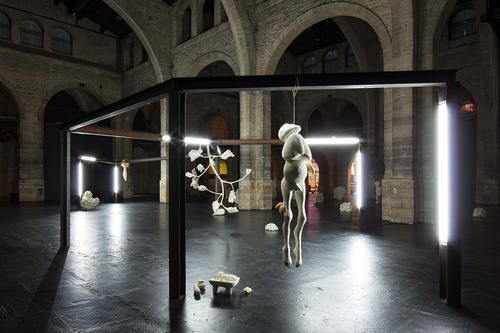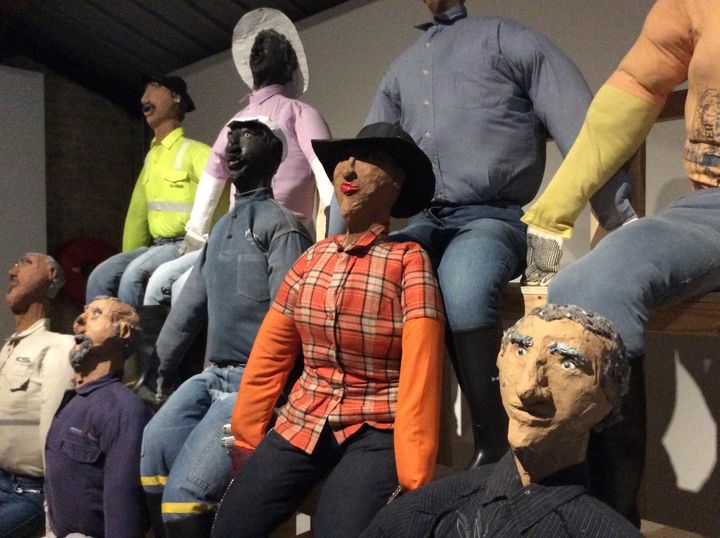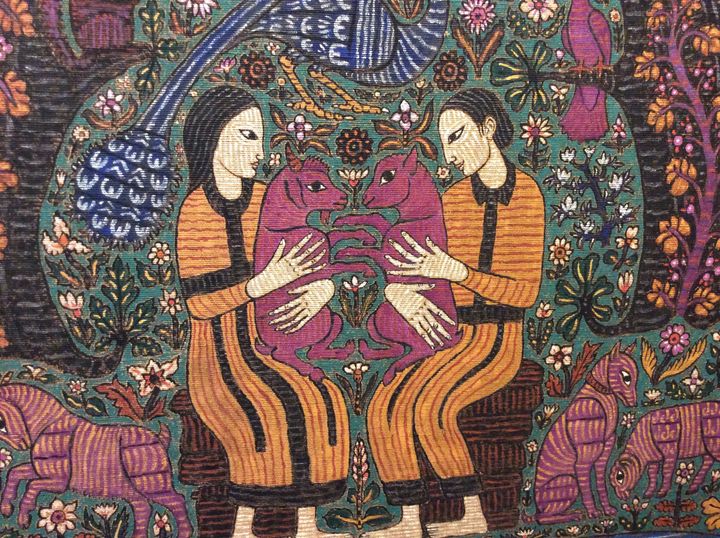
Photo (c) 2017 Arthur Pequin
Thick glistening bananas and vining mango trees pulse through the darkness in Bordeaux, the heart of the world’s finest wine district in southwest France. As you approach them mounted on steel racks, feet and hands sprout out of these succulent polystyrene plants while mangoes burst out from the knees and thighs and disconnected hands.
All these transgenetic creatures seem to dance through the darkness in the great nave of this city’s Museum of Contemporary Art (CAPC), once an enormous wine warehouse on the waterfront. Their creator, Naufus Ramirez-Figueroa, gives tribute to the Swedish scientist Carl Von Linné whom every biology student learned gave us the names for most of the world’s living species, plant and animals alike. These art-born creatures, however, defy Linnean categories even as they take us back into the human and vegetative experimentation that accompanied the British, Spanish and American colonization of central America all the while disposing of the native Mayans once they ceased to be useful workers.

Photo (c) 2017 Arthur Pequin
A native Guatemalan whose family were persecuted by a US backed dictatorship, Ramirez-Figueroa leads us seductively into this industrialized darkness from which our daily breakfast fruit comes. Hanging mango corpses, banana torsoed children, graceful chocolate tree hands populate this experimental garden. Ramirez-Figueroa’s magic comes from his clever theatricality. The pieces are beautiful, almost iridescent. Each tells a horrible, vaguely Sci-Fi story of life and death in a sort of ceramic “breeding farm” administered by remote multi-national food enterprises. Three personal video films accompany the expo on the second floor, recalling in metaphoric form a childhood nightmare where a young man grips a melting, dripping “ice baby” in a decayed aristocratic cemetery. In another he encourages models to lie down on raw, painted bed springs, leaving black marks on their bodies—a re-imagined version of the electrified torture rack the dictatorship used on its opponents.
Around the corner, we step into a room of wooden benches where visitors can sit with life size soft mannequin—men, women, children—resting from their struggle for survival. Colombian artist Oscar Murillo who calls this sculptural-video work, “Resonant Structures” (part of a series called, “The Economy of Living Things”) asks us to join him and his subjects and plunge into the dynamics of memory, labor, migration and color.

Photo Frank Browning
All art presumably bids us to enter both into the creator’s technique and into the artist’s parallel consciousness: there lie the secrets of vision. Da Vinci no less than Van Gogh no less than Picasso. Surely one of the most startling and largely forgotten painters and graphic artists of the last century, George Dorignac, occupies three floors of Bordeaux’s Musée des Beaux Arts, a half hour walk from the CAPC. If you’ve even heard of Dorignac, a Bordelaise by birth, you’re unusual; if you’ve seen his work, much of it a mixture of ink, black and ochre crayons and water color, you’re rare indeed. The vast majority of his pieces went directly into private holdings during the century’s first two decades. The current exhibit at Beaux Arts is the largest ever mounted. It is captivating and disturbing.

(c) 2017 Galerie Des Beaux Arts, Bordeaux
Like many young painters at the turn of the century, notably Renoir, he was captivated first by neo-Impressionist color and tenderness, particularly featuring nurturing women. Then by his thirtieth year, he moved much more deeply toward the inner lives and anguish of the women and men who, like Ramirez-Figueroa’s banana workers, found their bodies being ground up the relentless gears of industrial dawn.

(c) 2017 Galeries Des Beaux Arts, Bordeaux
Dorignac has been described as Rodin on canvas, and Rodin himself credited Dorignac with possessing a sculptor’s understanding of the stress, tension and fatigue of the human body. His colors and his hand strokes draw us inside the muscles and souls of women in the planting fields, men working the wharves, or the contemplative silence of women accepting loss.
As well and unusually for his time, his figures lead us away from the typical faces, shoulders and thighs of white northern Europeans, quietly reminding us that the people who gathered the grapes for our wines, loaded the cotton for our shirts or pounded the paving stones beneath our rails and roadways—all marks of colonial triumph--came mostly from hotter and more brutal climes than those recorded by Renoir and Monet. That rich history of empire and aristocratic wealth careened toward collapse as the First World War filled Europe’s waters with blood. At the height of the war, still not yet thirty, color invaded Dorignac’s pallet, guided by a fascination with Eastern, sometimes Byzantine images of swirling mandalas surrounding Edenic gardens of love and fertility.

Photo Frank Browning
* * *
Garden Pause. Should the intensity of these expositions at two of France’s finest museums weigh too heavily, a pleasant 45-minute drive through the world’s most important wine regions will take you into the heart of one of those wineries, Chateau Chasse-Spleen, that also has become a quiet, contemplative art garden. There you will find a singing iron plate, terra cotta flower pots handing from a maple tree, sighing sacks of sand and an array of other installations created by the late German sound and sight artist Rolf Julius.

Courtesy estate rolf julius / Galerie Thomas Bernard
- Cortex Athletico Photo : Florent Larronde
Nothing expresses his work more clearly than a comment he made several years ago: For a long time I've been thinking about how to create spaces into which one can retreat, where one can find quiet, where one can see, hear, where one is able to concentrate, where one is isolated from the world around but still is able to participate in it…by means of art or music or both. This is not an experience for a group. Lie down on the grass beside the steel plate, watch the leaves bustle above you and listen. Inside, small bowls whistle and offer tonal lullabies. Miniature microphones and miniature speakers link you to the worlds inside and surrounding each object, the sole object being to release calm and repose. A rarity in a world dominated by planet-threatening boors and ogres like T in Washington and P in Moscow.
(The wine, neither cheap nor especially expensive offers another sort of sublime.)
